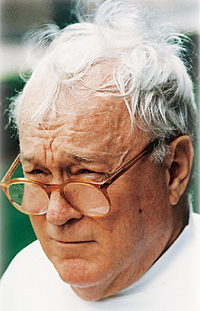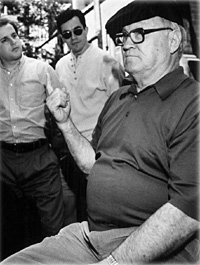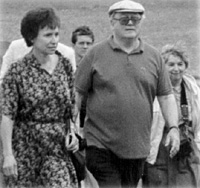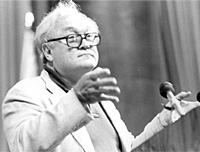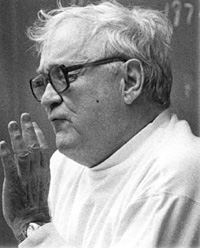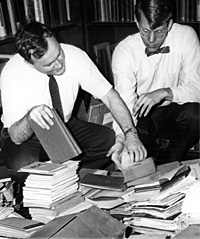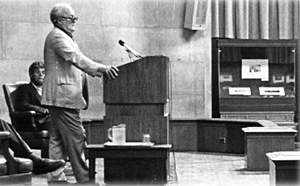|
|
 |
 |
 |
 |
|
FEATUREAlumni Remember Professor Jim Shenton ’49Columbia College Today has received a remarkable outpouring of letters and e-mail from alumni reflecting on Professor Jim Shenton ’49 and his impact on their lives. Some were published in our September 2003 issue, and we are pleased to present more here. Some have been edited for clarity and length. Due to space limitations, we are unable to publish all we received; many of those we have omitted echoed those that follow. Jim Shenton’s tragic death brought to mind his remarks to me in June 1959, shortly after I received my College degree. He said, “Trachtenberg, I predict you’re either going to end up in Congress, in jail or become a university administrator.” [Editor’s note: The writer is the president of The George Washington University.] Jim was a great teacher. He served as a north star for me for more than 40 years. He defined the Columbia experience. We will not see his like again. Stephen Joel Trachtenberg ’59 Jim Shenton brought history off the page. A master of cadence and intonation, he could have read the phone book aloud and had us spellbound. But he knew his subject deeply, and he was the master of the descriptive anecdote that made history real, affecting people with conflicts and emotions, the essence of good storytelling. The first assignment he gave was to read the Constitution. Out of that grew a paper I wrote for another class, which won the Charles A. Beard Prize for best paper in political science, and out of that grew a Guest Scholar position at the Brookings Institution right after graduation. Amazing that no one had asked me to read the Constitution before that. Jim Shaw ’71
Jim Shenton was my mentor as an undergraduate and graduate student, helping me in many ways and inspiring in me a lifelong love for history. Jim’s teaching was passionate, from the heart. It sometimes made us uncomfortable, embarrassed, when he would tear up during classes about the carnage of the Civil War. Thirty-five years later, I was to learn of the experience behind the emotion. In 1999, my son, John ’05, was an applicant to the College, and we looked up my mentor. In an instant, he remembered me and our student/teacher relationship, and insisted on taking John and me out to dinner — his treat, as usual, and no argument. It was then that I learned of Jim’s near-death experiences during World War II, of his seeing his friends blown to bits and of his escaping that fate by the sheerest of good fortune. During supper, I apologized for losing touch for decades after having benefited from so much of Jim’s help. When I finished my speech, he replied, “Hank, when you’re friends, 35 years doesn’t mean anything.” He gave John the same penetrating look that he had given me in 1964, when he decided to take me on as one of his many mentees. He liked what he saw, and offered his help with John’s application. John is in his junior year, and I am happy that he had a chance to connect with a piece of my history and Columbia’s history, and to spend an evening in the presence of a great man who was a friend, and a fighter to the end. William “Hank” Abrashkin ’66 It was a cold January morning in 1959, the last class before finals in Professor Shenton’s basic course in American history. We did not have to attend, he told us, as nothing he would talk about will be on the exam. Of course, we all showed up. Shenton came into class carrying a little phonograph, some records and a few books. He was going to talk about the beginning of the Civil War. He started slowly, with some background and quotes from a few of the texts — none very memorable. Then he put on a record, soft Southern backwoods music. “I am going to tell you the story of two brothers,” he said, “a slave owner who lived outside of Atlanta and an abolitionist from Boston.” He then began to read letters from the brothers, written during the mid- to late-1850s. The letters started quietly, friendly, with a great sense of time and place. Periodically, Shenton would change the record (oh, if he only had a tape player) and the mood of the music would change. Slowly, the music became more strident, which mirrored the stridency in the letters. He changed records again, this time The 1812 Overture. As that piece built to the dramatic climax, the brother from Atlanta wrote that this was the last letter he would write for a while, since he was enlisting in the Confederate army. The abolitionist brother also enlisted, in the Union army. Shenton slams the book closed with a bang. The canons go off outside Moscow in the recording and the bell rings signaling the end of the class. The class looks up to clap for the professor, as we used to do at the end of the semester, but Shenton was not there. The class sat still — not a word was spoken for a few minutes as we transported ourselves back to 1959. Forty-four years later, I remember that lecture. I have told this story to some of the high school students I interview for ARC, usually in response to a question about why I chose Columbia. “For the teachers,” I reply. Allen Breslow ’61 A standard task for Professor Shenton’s students in 1978 was to interview someone older than 50 about his or her life. I flew to Florida to talk to my Italian grandfather and his older sister. They argued and laughed about ancient events well after I had run out of tape, and later described that as the most fun they had together in years. I don’t recall what Shenton did with the transcript, but I know that I had to make copies for nearly 20 relatives who wanted to hold onto a piece of their history. Shenton showed us how to respect the past. Rosemarie Fabien ’80 Barnard As an undergraduate, I took Professor Shenton’s course that I believe was titled “Race and Ethnicity in American History.” The name of the course, though, is not important. Professor Shenton gave us the option of either taking a mid-term examination or conducting an oral history interview with a first generation American. I chose the latter option, and traveled to Rochester, N.Y., to interview my grandmother (then in her late 80s) and her best friend (also in her late 80s, and who was like family to me). I learned more about my grandparents, my family and myself that weekend than I could begin to recount here. I learned aspects of my family history that my grandparents had not shared with my father (Arthur Freeman ’58), and that might have been lost had Professor Shenton not sent me to Rochester. It was, without question, the most meaningful assignment I received during my four years at Columbia, and I will always be greatful to Professor Shenton for the experience. Alan M. Freeman ’93
I have so many fond memories of Professor Shenton, from his always full and active tea samovar to his daily pastries (we suggested that he should accompany his seminar syllabus with a menu!). One of my favorite stories, which I tell my students sometimes, concerns his supervision of my senior thesis. I went to him with grandiose ideas about writing about world peace, human rights, social justice, the Cold War, Gandhian non-violence and a kitchen sink full of other disparate ideas with which I was then engaged. Jim let me ramble on, sitting back in his chair, and smiled. When I finished, he looked at me and said, “How about the Austrian State Treaty of 1955?” I had no idea what he was talking about — I had never heard of the treaty and could not imagine what it was about, much less how it related to all that I had just said. No surprise that it turned out to be a brilliant suggestion. The treaty established the independence of Austria after its post-WWII occupation as a neutral state and was the only time that the U.S. and U.S.S.R. peacefully pulled out militarily from a country. (Iran in 1946 is another possible example, but quite different.) It was a specific and concrete historical moment that, it turned out, allowed me to explore many of the broader themes that I had so excitedly mentioned to him at that first meeting. I was so taken with the topic that it became the basis for my master’s thesis in international relations from the University of Cambridge. Shenton was a wonderful teacher, engaging scholar and such a great friend to me and many of my friends during our days at Columbia. I was very saddened to hear of his passing — there is much of him and what he taught me still in me, but now a small emptiness has replaced that part of me that wondered what and how he was doing, and hoping that someday we might reconnect. Ron Slye ’84 I was a junior at the College in 1967–68 as Columbia and the rest of the nation were being swept up in the intensifying maelstrom of the Vietnam era — war, assassination, presidential resignation and campus tumult. The turmoil of the world was compounded, in my case, by a depressing period of ill health and mental stress, one that threatened departure from school. As my professor in his memorable 19th-century American history class, Professor Shenton became aware of my situation. Despite his heavy involvement in the University politics leading up to the April upheaval on Morningside Heights, he found time to extend a helping hand with my studies in his course and in a most personal way. At his invitation, I was treated to dinner with him at Cedars of Lebanon restaurant on West 38th Street. It was my first taste of Middle Eastern cuisine and a most appreciated act of kindness on Professor Shenton’s part, one that helped keep me going when I wanted to quit. Strangely, I had been thinking of Professor Shenton quite a bit lately, not just of my experiences with him but also of the very moving and revealing article about him in Columbia College Today in which he related his World War II saga, which shed much light on his later anti-war activism. Lorne S. Birch III ’69 When I arrived on campus in September 1957, Professor Shenton already was enormously popular, and students would try to get into his Roaring ’20s lecture — in which he wore a raccoon coat and used a megaphone — even if they weren’t taking the course. But, together with the admiration, there also was concern. The word was out that, as an assistant professor, Professor Shenton didn’t have tenure, and there was a rumor that he would be gone if he didn’t publish a book pretty quickly. There was a figurative sigh of relief when his first book came out, and he became an associate professor. Much has been written about Jim’s love of food and drink, especially wine. I recall my senior seminar in European and American historiography. Back then, the legal drinking age in New York was 18, and each weekly session began with Jim bringing in a couple of bottles of a wine, about which he made some opening remarks, after which we imbibed and offered comments. What a congenial atmosphere and bond that created. Is it terrible that this is the most vivid memory that I have of that seminar? I consider it a gift that Jim spoke at the Class of 1961 40th reunion a couple of years ago. The voice, the mannerisms, the figures of speech, were all as they were so many years before; what nostalgia. For that half-hour or so, Jim made us feel young again! Barry M. Scotch ’61 I took Professor Shenton for a seminar on the history of World War II. He was incredible. His lectures were emotional and riveting and still have a way of stirring my emotions. Jeff Coalson ’95
James Shenton was the first professor at Columbia who pulled me aside and asked if I would be interested in pursuing a course of study at Oxford. I was fortunate to stumble across his Historian’s Craft Writing seminar and he let me in, even though I was only a sophomore. For three delightful years, I took practically every class he taught, including a summer class on World War II. I went on to take Professor Eric Foner ’63’s classes and major in history. It was not in the cards for me to leave the United States at the time, and to Professor Shenton’s disappointment, I never made any attempt to go to Oxford for study due to a death in my family during my undergraduate days that left me as a legal guardian to a younger sibling. But I will never forget Professor Shenton’s kindness in allowing my 12-year-old sister to occasionally audit his class. He showed his continued support by becoming my adviser/mentor and later writing a strong recommendation to law school. I will not forget his kindness during a semester when I could easily have gotten lost and perhaps even dropped out of college. Professor Shenton went beyond what most professors do in terms of showing interest, always taking students to dinner and really taking time to know us individually. Some thought his grand tales to be overdone. Not I. I still remember many of the words and phrases from his most famous lectures, from General Patton to liberating the concentration camp to the riots at Columbia to Octagon Soap. He was an amazing storyteller, and it was in his classes that I began to actually read the books in college, really read more than what was assigned, and think about how to craft my papers not just for his class but all my classes. How this man influenced my college days and my life is difficult to put in words, but when I think about college, the image of sitting on the floor waiting outside his office comes to mind … chatting with other student admirers, all of us waiting for a few minutes to talk and meet with this great man. Teachers like him are rare. He was brilliant, but not above teaching and connecting with his students. He enjoyed the relationships with his students and made me feel like I was the only one he was interested in talking to for those few minutes, even though tens would be waiting outside and hundreds passed through his office portal. He remembered you if you sent a random postcard; sometimes, he replied. I knew that there was an open door waiting for me at Columbia as long as his light was burning, and I am deeply saddened to learn of his death. A great man has passed on. He made Columbia College better. May he rest in peace. Jennifer A. Madrid ’92 I never took courses with Professor Shenton. Nonetheless, I always found his presentations mesmerizing. I took a tour of Old New York with him … I think it was part of a series of “Get to Know the Professors” events. His description of young immigrant women who died jumping from windows during a garment factory fire was particularly vivid. Shenton was proud to be affiliated with New York and Columbia. You can feel that from his description of how (Princeton’s) Aaron Burr shot our beloved Alexander Hamilton (Class of 1778). Shenton was omnipresent on campus, even for those who were not fortunate enough to have taken his courses. Most of all, I recall the many times he spoke about deflation. “If you think inflation is bad (pause for emphasis), you ain’t seen nothin’ until you’ve experienced dee-flation!” he’d boom. I’m not sure I understood what he was talking about at the time, but I assure you that after 12 years in Japan analyzing the economy, I do now. I am sure his legacy will not be forgotten for a very long time. Toshihiko Saito ’86, ’91 Business Before I even met Professor Shenton, he was a
living legend in my eyes. My high school history
teacher had been a pupil of Eric Foner ’63,
so I had heard quite a lot about the Columbia history
department. I met Jim at a lecture he gave at West
Point to the Columbia alumni of Westchester County,
a lecture my father had taken me to in order to
impress his alma mater on me. He needn’t have
worried. Once I heard Jim speak, I knew that I wanted
to attend the place that had produced him, and where
he taught. Jim mentored my application to Columbia, and he was as thrilled as I was when I was accepted. After that, we saw each other more and more, discovering shared interests besides American history. While describing one of the climactic battles of the Civil War, we would suddenly veer into a discussion of the diet of the opposing sides, comparing it rather unfavorably with the food of Molyvos (a midtown Greek restaurant), or Camille’s, or even my family’s Passover seder. Jim enjoyed new experiences, and preferably ones with interesting food. A taste for the gourmet was something we shared. I last saw Jim about a month before his death. I drove Jim, a strict pedestrian and passenger to the end, around northern New Jersey, and he provided commentary on each little block we passed. We started out at Passaic Falls, the second greatest waterfall in the United States after Niagara, and Jim described it and its significance to a passing gentleman from South America. But in discussing the waterfall, he didn’t stop at its beauty and grandeur, but went beyond and deeper, talking about how Alexander Hamilton envisioned this waterfall as the engine for a picture-perfect industrial town. Aside from the grand sweep of history, Jim always provided interesting anecdotes, like pointing out the building where the bombing of the World Trade Center was planned as we drove past it. He was fascinated by, in his own words, the bizarre nature of his native state. Our last meal together combined good food and history. We dined at the restaurant that had been the headquarters of the German-American Bund in the 1930s, but now, fortunately, was owned by Slovaks. Jim loved the place, and was well-known and liked there. He described how the turkeys were Vermont turkeys (a fact that induced me to order the hot turkey sandwich), how the soup stocks were made in such a distinct and delicious way and so forth. During the meal, Jim talked about his experiences in World War II, and about the lot of soldiers in general, relating it to the current world crisis. However, though Jim was not terribly fond of our selected president, it was not Iraq or the War on Terror but the breakdown of the barrier between church and state that he feared. He told me how he refused an invitation from a former student, who worked at the White House, to have dinner with the President. He refused because he would not pray with the President, and prayer is now required before each meal in the White House. Jim stuck to his convictions, and he had a true understanding of the nature of our government and society. Jim spoke of the randomness of things. Our meeting was one of them, and it seems as though something good came out of it. Jim was a New Yorker in spirit, present everywhere and beloved everywhere. I was privileged to know him, and I only wish we could have continued our relationship for many more years. Jacob Hupart ’05
I met James Shenton during my first week at Columbia. He gave one of his celebrated walking tours during freshman orientation, and our little group followed him as he rambled from Columbia down the West Side. What a joy to listen to him as he pointed out architecture, the natural and political history of Manhattan, the customs of pedestrians, and just plain great places to eat. I took in everything, concentrating so intensely I ran smack into a fire hydrant. That moment flared up when I read of Professor Shenton’s death. He was never again a direct force on my life — I did not study with him or meet him again. But throughout my time at Columbia, I always heard his name. One always knew of his dynamism and his passion for politics, especially during those politically charged days of 1985. And to this day I remember him, the person and the persona, that wonderful man and his wonderful tour. Raymond Montalvo Jr. ’85, ’90 GSAS Like many members of the Class of 1955, I regarded Jim Shenton as our patron saint or class mentor because he had begun teaching just as we were entering Columbia. I had the honor of being in the first class he taught, Contemporary Civilization A, in the years when CC was a two-year sequence. I thought CC was the best course I had at Columbia, and still have the books and notes. I also still have a paper I did in the course, an essay on Rousseau. It was turgid, partially because Rousseau was difficult, mostly because I was dense. When Jim returned the paper, it had extensive criticisms, which no freshman likes to receive. But what struck me then, and even today, was that the criticisms were not only correct, but kindly phrased, intended to improve my thinking and writing, not to show off the instructor’s superiority. I learned not only about Rousseau, but about decent behavior. Later, I took Jim’s famous survey course in American history. The annual highlight was the lecture on the 1920s, complete with jazz music, appropriate dress and a “flapper,” recruited from Barnard, who would invade the class and dance suggestively at the proper moment. That was when Jim would tell us that skirts got so high in the flapper era that women came to powder “not two cheeks, but four.” For sex-ignorant students of the 1950s, it was most provocative. The last time I heard Jim lecture was at a Dean’s Day shortly after the fall of the Soviet Union and the reunification of Germany. Jim, a pacifist veteran of World War II, was furious that the United States had facilitated the return to European dominance of the country he had helped to defeat. Fortunately, his worst fears of the resurgence of German nationalism have proven unfounded, and I think he would be amused and gratified by the rise of anti-war sentiment in the former enemy. Jim had no nuclear family, but he had a family of devoted students for more than five decades. My son, Miles ’89, said it well: “He was a great teacher [who has] doubtless inspired others to do the same. So, in a way, he will live on, long after the physical body. Not many of us could say the same.” Gerald Pomper ’55 I entered Columbia College in September 1957 and was fortunate enough to get Professor Shenton for my Contemporary Civilization course. Simply put, he brought the history of past eras to the present with funny anecdotes of great historical figures, making them real and very human in each class. We all looked forward to those classes, and I never forgot them. They were the highlight of my Columbia experience. Professor Shenton was one of a kind, as all those who attended his lectures or who knew him will attest and remember. I remember thinking that when I retire, I will study history because he made what some consider a dry subject exciting and contemporary. James Shenton represented the best that Columbia has ever offered its students. Stanley Klein ’61 Columbia College will not be the same without Professor Shenton. His warmth and devotion inspired a sense of community, a feeling so difficult for a campus so hemmed in by the City of New York. As a teacher, he made history live. I attended his justifiably famous American history survey course. He challenged all theories as he brought old personalities to life, airing their many (often complex and contradictory) motives to the fore. We watched Hamilton struggle and intervene in favor of Jefferson over Burr. When he portrayed John Quincy Adams as a man of honor, one student shouted, “At last, a hero!” to which Professor Shenton reminded us of another aspect to consider: The heroism stood, but with the touch of human frailty. His approach influenced me greatly. Since his class, I have tried to understand social events (past and present) through the eyes of participants who, as humans existing within great forces of history, are trying to advance various interests and causes. This empathy extended beyond the classroom in his regard for his students. Robert R. Morgan ’60 Professor Shenton talked about the Civil War as if he had been there. In the middle of one lecture, I looked around the room and almost everybody had stopped writing. Everyone was mesmerized. He made the Civil War come alive. It seemed as if he was telling us a story of something that had happened to him a few days ago. At the end of his lecture, everyone was clapping. This was a typical Shenton class. James P. Shenton is the type of professor that I would have wanted my son or daughter to have as a professor and as a friend. He cared about his students as individuals and had a positive impact on many of us. I was fortunate to have been in Professor Shenton’s class and senior seminar for two years. He definitely leaves a void at Columbia, and in all the hearts and minds he touched. We will miss him. Francisco Galvan ’76
Not only had Professor Shenton inspired me when I took his Race and Ethnicity in America class as a sophomore, but he was also something of a mentor to my father, John L. Erlich ’59. I remember the first day of class. As Professor Shenton read the names from student roll, he stopped on mine. He asked me if I was the son of John Erlich, a student of his from the ’50s. I was impressed that he remembered my father’s name after 26 years; soon thereafter, he invited me and another legacy student to dinner and lively discussion. That gathering, a small but generous gesture, helped a 19-year-old Californian feel like he was part of a community and get over his nagging homesickness. Professor Shenton’s lectures and the class discussions in Race and Ethnicity helped teach me how to think critically about history and current events. His broad knowledge and enthusiasm for the study of ethnic histories inspired me in my studies of urban sociology and, later, city planning. Thanks in part to Professor Shenton, the study of American racial and ethnic history continues to be a passion of mine. John J. Erlich ’87 Jim Shenton was my mentor, role model and friend during my undergraduate years, and he continued in these roles for many years thereafter. He piqued, nurtured and sustained my interest in history and encouraged me to go to graduate school and to follow my heart to become an historian and teacher. He was the finest undergraduate teacher I had or have known, and I say this knowing that I was privileged to have many extraordinary teachers at Columbia and that I have encountered many exceptional teachers during my four decades in the profession. Jim brought high intellect, vast knowledge and indomitable commitment and passion — for his subject matter and for his students — to the classroom. He always spoke truth to power, during the bland 1950s, the raucous 1960s and the decades that followed. And he encouraged others, by word and deed, to demonstrate the same courage. He brought history alive, and into our lives, and made crystal clear that if we did not understand what had gone before, we would not be able to deal with what was happening all around us as well as looming on the horizon. He was, in the best sense, democratic, egalitarian and outspoken, yet unfailingly respectful of the rights and convictions of others even while he unashamedly pressed his powerful insights and beliefs. He lectured (without notes) to overflow classes, invited inquiry and took on all doubters with a warm heart as well as firm but respectful response. He advised an endless flow of students who made their way to his office on the cramped top floor of Hamilton Hall to seek the advice that we needed and that he gave with great wisdom and unstinting generosity. In my case (as was the case with so many others), he kept in close touch during graduate school years, helped with obtaining first jobs, oversaw the writing of a book in a series he edited and took great joy and pride in sharing in the development and achievements of every one of his veritable army of students. And in the years that followed, when time and circumstance allowed for members of his legion to return to the Columbia campus, Jim was always there to talk about matters academic, societal, global or personal. Jim set his own — and the highest — standards as a teacher, scholar and humanist activist. His mind and life were inextricably and profoundly tied to Columbia College and the students who filled its hallowed halls. But if ever there was one teacher who was a veritable institution unto himself and who left a lifelong influence on all those students who were fortunate enough to find their way into his classroom or office, or even engage with him on the steps of Hamilton Hall, it was James P. Shenton. I mourn the death of this gallant teacher but rejoice in his legacy. Arnold A. Offner ’59 Without Professor Shenton, I certainly would not have been able to attend Columbia and very likely would not have been able to proceed to graduate school and an academic career. On one of his recruiting tours, Professor Shenton found me floundering in high school in Ohio and somehow decided that I was worth recruiting. With generosity and kindness that astonishes me to this day, he invited me to visit Columbia late in the application season, arranged a place for me to stay, took me to dinner with other students, encouraged me to apply, and, I suspect, wrote a door-opening letter for me. To my elation, I was accepted. Then, as a floundering pre-med freshman, the encouragement of Professor Shenton (along with Dean Patricia Geisler) kept me going. I do not know why Professor Shenton believed in me, as my grades had been mediocre. But he did, I began to find my way, and I have gone on to a career in academic medicine. Thanks, Jim. Whatever good I do, you have made possible. Eric Krakauer ’79 M.D.
Having attended Columbia College almost a half century ago, my biggest regret is that I was not one of “Jim Shenton’s boys.” I took Jim’s course and did decently. I admired, respected and trusted him, but viewed him from a distance. I was awed by Jim’s energy, love for his students, commitment and brilliance. In retrospect, I know that why I did not venture too close to Jim is that I wanted to view him as perfect. We had great professors who were charismatic and passionate, but for me, Jim was the best of the best because he made history come alive. I close my eyes and still can sense the excitement he communicated. Henry Adams wrote, “A teacher affects history; he never can tell when his influence ends.” I do not doubt that Jim profoundly influenced me to start The John Dewey Academy (in Great Barrington, Mass.), which offers intensive and individualized instruction and therapy for gifted, angry and self-destructive adolescents who desperately need a safe, secure and structured residential placement. We have a great teaching staff; most possess doctorates and have taught college. All our graduates attend quality colleges. Seven percent have gone to Columbia College and the University and all have made the Dean’s List. But John Dewey has no Jim Shentons. He was one of a kind. He remains suspended in my mind as the dynamic force he was for so many of us during the 1950s and 1960s. Shenton remains the best of the best. I eternally am grateful I took Jim’s course, but cannot imagine Columbia College without him. Thomas Edward Bratter ’61 At the end of my freshman year, a classmate went blind. Some of us worried that the same might happen again. During exam week, I noticed a strange black tangle in my right eye. I went to Columbia Health Services, and they sent me to the Eye Institute, where I met Dr. Anthony Donn, who examined my eye, drew a picture of what I was seeing, and told me I had a persistent hyaloid artery that I had had my whole life. Thus, there was nothing to worry about. I felt enormously better, so much so that when I got back to campus, I went straight to my adviser, Jim Shenton, and told him I had “degenerated into a pre-med student” and that I had decided to switch from pre-law to pre-med and would change my major from American history to chemistry. “Jesus, Patten, are you crazy?” said the great man with a face that looked like a child rejecting sour milk. I tried to explain how impressed I was with Dr. Donn, who knew everything about Kant (the author of the book I was reading in the waiting room) and how much better I felt, but more than that, how powerful medicine was that it could make you feel so good even when you had nothing wrong with you. “You are crazy,” said Professor Shenton, who sent me for psychiatric and psychological examination. I was in the office when the psychiatrist called Professor Shenton and told him, “The kid just wants to be a doctor. So what’s wrong with that?” Two psychologists said the same. So, Jim approved my change in plans, and he and I remained friends up to his death. During the 40th reunion, Jim still was of the opinion that I had made a mistake, but he seemed to like the idea of my giving him advice and holding his hand during some of his recent medical ordeals. Bernard M. Patten M.D. ’62, P&S ’66 It’s not often that a professor with whom you never took a class could have such a profound impact on your academic career, but then again, Jim Shenton was no ordinary professor. Professor Shenton served as my de facto adviser in 1994, toward the tail end of his career and the end of my Columbia College experience. I transferred to Columbia during my junior year and only became aware of the “Shenton experience” during my final year. I quickly developed a friendship with Professor Shenton, was treated to his famous dinners, and was sponsored by him for a Kellett Fellowship — all the while regretting that I would soon graduate and no longer be able to sit at the feet of this master. One of my fondest memories of Professor Shenton is taking a field trip to Virginia with a group of his students to visit the Civil War battlefield sites of Cold Harbor, the Wilderness and Spotsylvania Courthouse. At one point, Professor Shenton singled out some of the more athletic members of the group and had them walk across the field to what was the Union side. He then called out for those students to charge at us at full-speed in order to demonstrate how much of a turkey shoot it was for Confederate soldiers to defend their position and the futility of military techniques of the time. Instead of lecturing about it, Professor Shenton demonstrated that history had to be lived; only by making history into a sensuous experience could a historian even begin to properly tackle a subject. Our trip to Virginia left me in awe not only because Professor Shenton easily was one of the best teachers I never formally had at Columbia, but because of the constant wonderment of what taking one of his classes must have been like at the “prime” of his career. Noah Littin ’94 Jim Shenton was undoubtedly the most important influence on me in terms of my teaching style, intellectual interests and political values. And, of course, that big fat dose of humanity he exuded made him one of the true menshen of the world. I took several of Jim’s undergraduate classes, including his rightly famous Civil War seminar, and I was his first Ph.D. mentee. He was so great a teacher and so good a man, I even forgave him for leaving an early draft of my dissertation in a taxi! Gerald Sorin ’62
As a 17-year-old high school student growing up in Newark, N.J., I took a public bus to school each day. One morning, James Shenton boarded the bus and sat down next to me. He was on sabbatical from Columbia that term and was teaching history at a local secretary’s school. We immediately struck up a conversation, and continued it morning after morning as we met on the same bus. When, months later, he asked what my plans were for college, I had no idea. And so it was because of Shenton that I wound up at Columbia. In July, when I learned that Shenton was ill, I flew to New Jersey to visit my adviser and mentor in the hospital. While I was there, hundreds of cards poured in day after day from five decades of Columbia alumni. Each card had a unique story to relate, as former Shenton students from all corners of the globe took the time to write to a teacher who they so admired. I read these cards to Shenton during his final days. The cards made me realize that those of us who knew and loved James Shenton shared much more than a charismatic professor who was keenly interested in the lives of his students. For so many of us, Shenton was also a lifelong friend. When I was an undergraduate, I once wasn’t able to find a particular history book in the library. When Shenton heard about this, he gave me the key to his office, 324 Fayerweather Hall, and said I could borrow the book from him. When I tried to give the key back, he wouldn’t take it. I have carried that key ever since. Through a chance meeting on a public bus, James Shenton changed my life more than any other person. He will remain a part of me forever. In this sense, I believe that I am not unique. What made Shenton special was that he made so many of us feel like he was giving us a key to his heart. We’ll miss you, Jim! Eugene D. Mazo ’95 Professor Shenton was a wonderful example of a committed scholar who was able to integrate his passionate pursuit of knowledge and joy in teaching with engagement in the world outside of academia. I grew up in Paterson, N.J., near his hometown of Passaic. A cousin of his was my high school classmate. I met Shenton at a local meeting of volunteers in the Eugene McCarthy for President campaign. It turned out to be a historic occasion, as it was the night that President Johnson announced he wouldn’t seek re-election. My older brother went to Columbia and was active in the 1968 student strike. Shenton’s courageous stand on behalf of the students won my admiration. Later, as a student at Columbia, I took several of his courses including a seminar on radical American history. Shenton helped make my Columbia education unforgettable. Paul Fitzgerald ’95 Professor James P. Shenton supplied me with my most enduring memories of my Columbia education. My father visited me on campus in 1985 or ’86 and asked if he could sit in on one of my classes. I immediately recommended Professor Shenton’s Ethnicity in America course, as he was the most spellbinding speaker of my professors. The class that day covered immigration to the western United States from China and Japan in the late 19th century. After Professor Shenton elaborated on the tribulations that Chinese immigrants tended to go through in those days, he asked rhetorically why Japanese immigrants on the whole escaped the same fate. He answered his own question by pointing out that Japan was a rising military power with a strong navy. And then, in a moment I shall never forget, he enacted a hypothetical Japanese government response to American mistreatment of Japanese immigrants: “You cut the SHIT!” he hissed, finger stabbing the air. “We’ll blow your asses out of the goddamn water!” One could hear a pin drop in the auditorium. I stole a glance at my father. He was transfixed. As we walked down the steps of Low Library after class, I asked my father what he thought about the experience. He said he was glad his money was being well spent. W. Dean Pride ’88
|
|
||||||||||||||||||||||||||||||||||||||||||||||||||||||||||||||||||||||||||||||||||
